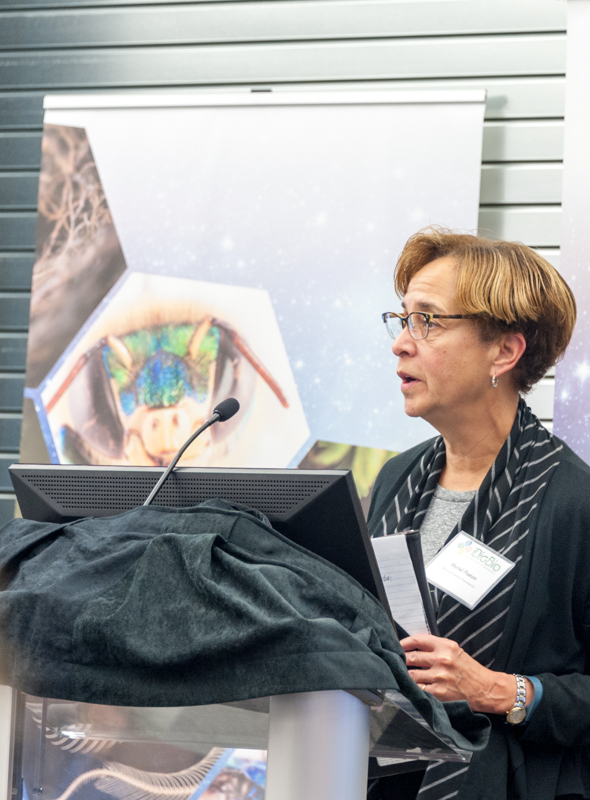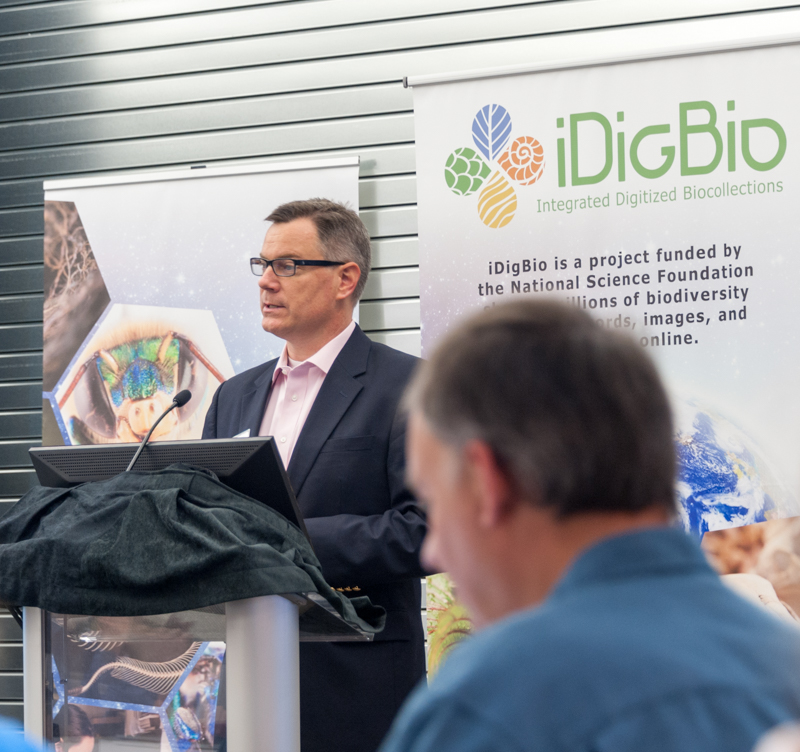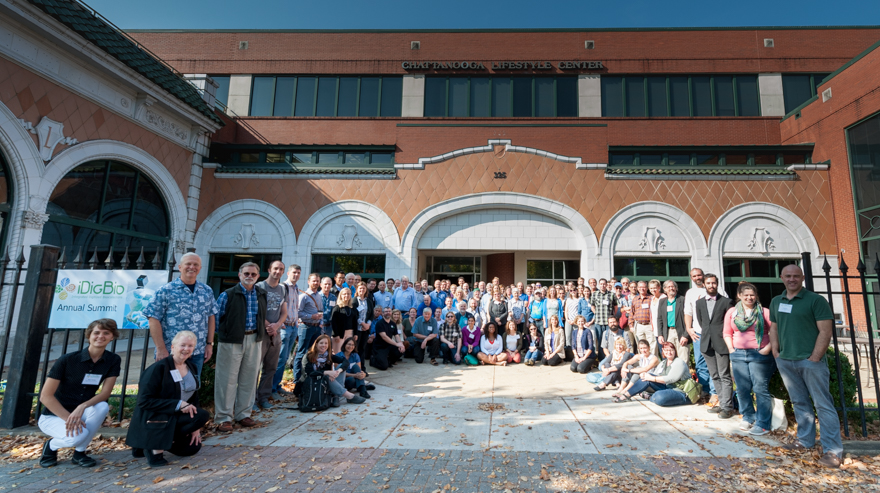 The Advancing Digitization of Biological Collections Annual Summit, hosted by iDigBio, took place in Chattanooga, Tennessee, at TechTown November 1-3, 2016. Surrounded by technology and with bean bags for comfortable discussion, TechTown was an inspirational space for the Summit.Tuesday was set aside for meetings of several organizations including the Natural Science Collections Alliance, the new LepNet Thematic Collections Network (TCN), and the iDigBio External Advisory Board. In the afternoon, there was also a special introduction to iDigBio for new TCN members.
The Advancing Digitization of Biological Collections Annual Summit, hosted by iDigBio, took place in Chattanooga, Tennessee, at TechTown November 1-3, 2016. Surrounded by technology and with bean bags for comfortable discussion, TechTown was an inspirational space for the Summit.Tuesday was set aside for meetings of several organizations including the Natural Science Collections Alliance, the new LepNet Thematic Collections Network (TCN), and the iDigBio External Advisory Board. In the afternoon, there was also a special introduction to iDigBio for new TCN members.
All Summit participants attended Wednesday which began with introductions and welcomes from David Jennings (iDigBio), Muriel Poston (NSF), and David Reed (FLMNH). These were followed by presentations and discussion about the national digitization effort including talks from ADBC program officer Roland Roberts Larry Page, Director of iDigBio, and Rob Gropp from the Biodiversity Collections Network. Major themes included sustainability and broadening digitization participation, and data use for research and education.
 The majority of Wednesday consisted of presentations from current TCNs beginning with the oldest – those funded in 2011 – and concluding with the 2016 TCNs, the newest being only 47 days old! Each TCN representative touched on five topics: progress in digitization, data management and open access, research, management and oversight, and what have we learned? You can find their slides and recordings of the presentations on the Summit Wiki.
The majority of Wednesday consisted of presentations from current TCNs beginning with the oldest – those funded in 2011 – and concluding with the 2016 TCNs, the newest being only 47 days old! Each TCN representative touched on five topics: progress in digitization, data management and open access, research, management and oversight, and what have we learned? You can find their slides and recordings of the presentations on the Summit Wiki.
After Wednesday’s agenda drew to a close, Summit attendees met at the Tennessee Aquarium for a reception surrounded by living collections. The evening was generously co-sponsored by the aquarium, and the Director, Anna George, delivered a wonderful presentation entitled “Harnessing the Power of Living and Natural History Collections for Southeastern Aquatic Conservation” inspiring us all to consider the value of collections in preserving and rehabilitating freshwater ecosystems. After the presentation, participants were given time to mingle and view the fantastic aquarium exhibits.
 Thursday began with a series of inspirational talks from Doug Jones (Director of the Florida Museum of Natural History), Jon Coddington (Global Genome Biodiversity Network), Jennifer Hammock (Global Unified Open Data Access and Encyclopedia of Life), and Mary Klein (American Institute for Biological Sciences). We also viewed two newly released videos created in collaboration with BetterMe Productions called Why Digitize? and Museum Specimens as Time Machines. The morning session ended with an open room discussion focusing on our collective priorities for the next five years. Some of the themes of the discussion included reaching out to new communities (such as citizen scientists, ecologists, and conservation researchers) and how to make our biodiversity data more discoverable.
Thursday began with a series of inspirational talks from Doug Jones (Director of the Florida Museum of Natural History), Jon Coddington (Global Genome Biodiversity Network), Jennifer Hammock (Global Unified Open Data Access and Encyclopedia of Life), and Mary Klein (American Institute for Biological Sciences). We also viewed two newly released videos created in collaboration with BetterMe Productions called Why Digitize? and Museum Specimens as Time Machines. The morning session ended with an open room discussion focusing on our collective priorities for the next five years. Some of the themes of the discussion included reaching out to new communities (such as citizen scientists, ecologists, and conservation researchers) and how to make our biodiversity data more discoverable.
 After the morning break, the conference broke up into four discussion sessions to learn more about specific topics, brainstorm about challenges, and develop new working groups/action items to tackle and document tasks and projects determined as critical for collections digitization and data discoverability in the coming years. The discussion topics included citizen science, sustainability of TCNs, what to digitize next, and data quality. You can find discussion summaries, notes, and slides on the Wiki.
After the morning break, the conference broke up into four discussion sessions to learn more about specific topics, brainstorm about challenges, and develop new working groups/action items to tackle and document tasks and projects determined as critical for collections digitization and data discoverability in the coming years. The discussion topics included citizen science, sustainability of TCNs, what to digitize next, and data quality. You can find discussion summaries, notes, and slides on the Wiki.
 After lunch, the conference once again broke into a series of discussion groups. This time, the topics were on tools and skills for using the iDigBio data services for research, effectively managing digitization projects, data quality for downstream use, outreach, attribution and citation, sustainability of the national digitization effort, extending data schemas, and educational resources.
After lunch, the conference once again broke into a series of discussion groups. This time, the topics were on tools and skills for using the iDigBio data services for research, effectively managing digitization projects, data quality for downstream use, outreach, attribution and citation, sustainability of the national digitization effort, extending data schemas, and educational resources.
In addition to the over one hundred participants present at the Summit this year, the event also reached a wider online audience. Remote participation was offered through Adobe Connect for most of the meeting and there were 33 unique remote participants who joined throughout the conference. People could also follow along on Twitter with the hashtags #ADBCSmt6 and #iDBSmt6 which amassed a combined 58 posts and a reach of 20,668 Twitter users.
iDigBio worked with We Are Neutral to offset the carbon footprint of the meeting. In the coming months, We Are Neutral will plant more than 100 Longleaf Pine trees in a conservation area in Florida on behalf of the Summit. Last, but not least, a digital Summit program was created saving on paper. The electronic version can be found here and includes a wealth of information not in the Wiki, such as participant biographies and TCN and collaborator project overviews. You can find more photos on the iDigBio Facebook page. If you are interested in the participants' reflections on the summit, you can read the summit evaluation report.








